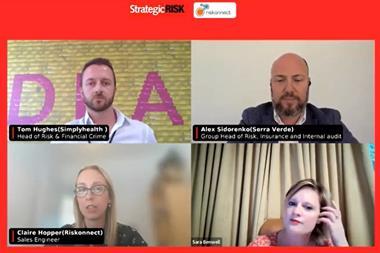Dan Trueman discusses how businesses can protect their key intangible assets
Intangible assets are becoming an increasingly important component of modern business, particularly as companies in many of the developed countries are moving away from a manufacturing based environment into a more services based model. Such companies depend for their future success on maintaining their reputation and safeguarding their intellectual property (IP). Both reputation and IP can be evaluated in terms of the revenue they generate and, in turn, companies should be able to protect that valuable revenue with insurance.
IP is a key element of their business for many enterprises. Traditionally, IP has been associated with patents, trademarks, copyright and the like. However, in today’s world those are just the tip of the iceberg.
IP can embrace a whole range of intangible assets such as trade secrets, data bases, innovative systems and the research and development (R&D) dedicated to a specific project. Protecting IP can be vital, not only for generating revenue but also, for example, to give the business the confidence to embark on R&D and to provide assurance for investors.
In addition, many companies rely heavily upon their reputation. Not only does this help to promote sales but in some cases it generates a premium for their products or services. Like IP, reputation is a massive generator of revenue.
Charles Fombrun, chairman and co-founder of Reputation Institute has said that reputation produces a “cushion of goodwill” should a crisis occur. Reputation is what keeps bringing customers through the door – and what brings them back after a disaster. And fear of losing corporate reputation is one of the things most likely to keep CEOs awake at night.
However, what constitutes reputation – and how to protect it – are taxing issues. A recent discussion by UK risk management association AIRMIC and thought leaders in reputational risk and risk governance focused on exploring best practice in identifying and managing reputational risks. The findings were that the scale and scope of potential threats to organisations warranted greater emphasis on this threat at board level and engagement with key stakeholders to understand the specific risks inherent in the various stakeholder relationships.
Valuing your IP and reputation
Recognising the important contribution that IP and reputation make to the total value of an organisation, the accountancy profession has devised a number of methods to include their values in the balance sheet.
IP is usually expressed as the value of intangible assets and is often calculated on a forensic accounting basis which tends to mean that it is done on a backward looking rather than forward looking basis. Goodwill valuation accounts for reputation but the formula commonly used relates to share price. Again, this is not ideal as there are many unrelated factors which can affect share price.
Brand consultancy Interbrand’s annual listing of the world’s 100 most valuable brands uses other criteria (see box). While a useful reference, it does not look at the revenues that could be lost if brand reputation was damaged. And we believe that revenue is key when measuring the value of IP and reputation.
When IP is lost or invalidated, revenue is disrupted or can totally disappear. With reputation which is the glue that binds the activities of an organisation to its clients, damage or destruction will have the same effects on revenue. It may take a long time to recover if indeed it does at all.
What are the risks?
The key risks for IP are invalidity, injunction and rule changes. The latter are an increasing problem as regimes can change quickly in different territories.
Risks to reputation are much wider. As Warren Buffett famously said, “It takes 20 years to build a reputation and five minutes to ruin it.” One of the best examples of this was Gerald Ratner’s speech to the Institute of Directors in April 1991 when a joke that deprecated the products of the jewellery chain he headed misfired with consequent substantial reputational damage not only to the business but to Ratner himself.
Reputational risk is particularly important in view of today’s far outsourced supply chains. Few companies have full control over their entire supply chain and it’s difficult to ensure that one of your suppliers is not sub-contracting to another business that might not meet your criteria. The case of the Mattel recalls in2006 and 2007 is a typical example when the company announced recalls of millions of toys made in China because of possible hazards to children.
If you log on to one of the online search engines and search for reputational risk over the last year or two, you will see an enormous number of hits. It seems that everything carries some form of reputational risk for companies. It might be having a new change strategy - or not putting a change strategy in place – or bankers having bonuses or not having bonuses.
Reputational risk is a very wide term and an enormous number of risks can be involved in reputation management. The reputational risks category can include anything from inappropriate action of directors/executives and breaches of corporate social responsibility, to product recalls, and, perhaps more importantly, the failure after a problem of crisis management processes and public relations initiatives to do a good job in restoring confidence. Restoring confidence is key. The cushion of goodwill can quickly be used up if a business does not respond positively to an incident. On the other hand, dealing well with the “fall out” will not only minimise damage but may even enhance a company’s position.
A good example of this is Johnson & Johnson’s product recall of Tylenol in the early 1980s. Following the news that seven people had died from ingesting capsules laced with cyanide, Johnson & Johnson immediately instituted a public relations programme to protect their reputation and that of the brand. The programme was two-fold; first dealing with crisis management and, second, facilitating reputational recovery of both Johnson & Johnson and the hitherto profitable Tylenol brand. As a result of its speedy and efficient action, the company recovered with no loss to its own reputation or that of the Tylenol brand.
If reputational risk is an overused term, so too is balance sheet protection, often presented as the target for managing IP and reputation risk. IP and reputation generate revenue and what is far more important to the lifeblood of a company is cash flow. If IP is lost or reputation is terminally or badly damaged then that cash flow disappears.
Can insurance help?
There are insurance covers in place for the legal fees associated with patent protection, the costs of product recall and even some of the associated expenses. But what many insurers have failed to recognise until recently is that the revenue loss is the key concern for many companies when looking at their IP and reputation risks.
It’s a difficult concept for the insurance market to grapple with as it presents considerations which are not traditional. For a start, loss does not result from physical damage. As well, there may not be the conventional insurable interest. A reputation loss can stem from a supplier’s or other contractor’s act or negligence. However, there is a genuine loss which can be measured in revenue terms – and we believe that that is insurable.
Conventional business interruption insurance covers loss of revenue from physical damage of assets. It is not such a great leap to cover loss of revenue resulting from impairment of intangible assets providing that both client and insurer understand the factors involved and the potential loss. It’s not reinventing the wheel – merely fine tuning it to meet modern requirements.
In order to assess your needs and perhaps get this kind of protection, you need to evaluate your risk. Where IP is concerned this means identifying all the elements of your business’s operations which involve some degree of intellectual property. Then comes a process of due diligence. You may have already done IP due diligence before but risks change and it’s worth a revisit. Having assessed the robustness of the processes you have in place, there is likely to be some residual risk – which is where insurance comes in.
You might not want to insure all your IP – just some crucial elements where people might infringe a key product or a new system that you have put into place.
In the case of product recall, you need to look at the potential risks and impact on revenue if there was a massive recall in one country or regime. In this case, it’s important to view the US as what it is – a conglomeration of states each with their own local regulations.
A revenue related insurance policy for IP and reputation risk is not an off-the-shelf purchase. Our experience shows that every client’s needs are different, reflecting their individual concerns and what is actually likely to happen if something goes wrong. The type of indemnification they need also differs, for example taking into account their fixed and variable costs.
In negotiating cover, the partnership aspect is paramount. We spend a lot of time and effort talking to firms and discussing their processes. Key to this is their due diligence – not the tick list that they may have when they undertake this but the philosophy behind it. There’s no point in having a tick list if you don’t believe in it!
Interest in this type of insurance is coming not just from the intangible asset dependent sectors such as technology and life sciences but also from professional service providers like accountants and solicitors, particularly in the case of reputational risk; and the food and drink sector, which is clearly concerned about recalls. Interestingly we are also seeing enquiries from what we would consider ‘old economy’ type players such as mining companies. They are concerned about the reputational issues associated with a breach of corporate social responsibility. CSR might historically have been something people paid lip service to and talked about only in their report and accounts. Now it is a genuine reputational damage issue.
Interest in this insurance has increased markedly in the last six months. We attribute this both to the Tiger Woods scandal, illustrating how reputation can take a nose-dive, and the Toyota recalls.
Companies are becoming increasingly aware of the value of their intangible assets. Offering insurance protection has necessitated some innovative thinking but we believe that now the market is responding to their needs. Insurance can never replace good risk management but it’s a valuable recourse should the worst happen.
Interbrand’s top 10 2009 brands
1. Coca-Cola 68,734 ($m)
2. IBM 60,211 ($m)
3. Microsoft 56,647 ($m)
4. GE 47,777 ($m)
5. Nokia 34,864 ($m)
6. McDonald's 32,275 ($m)
7. Google 31,980 ($m)
8. Toyota 31,330 ($m)
9. Intel 30,636 ($m)
10. Disney 28,447 ($m)
Postscript
Daniel Trueman is active underwriter of the enterprise risks division at Kiln



















